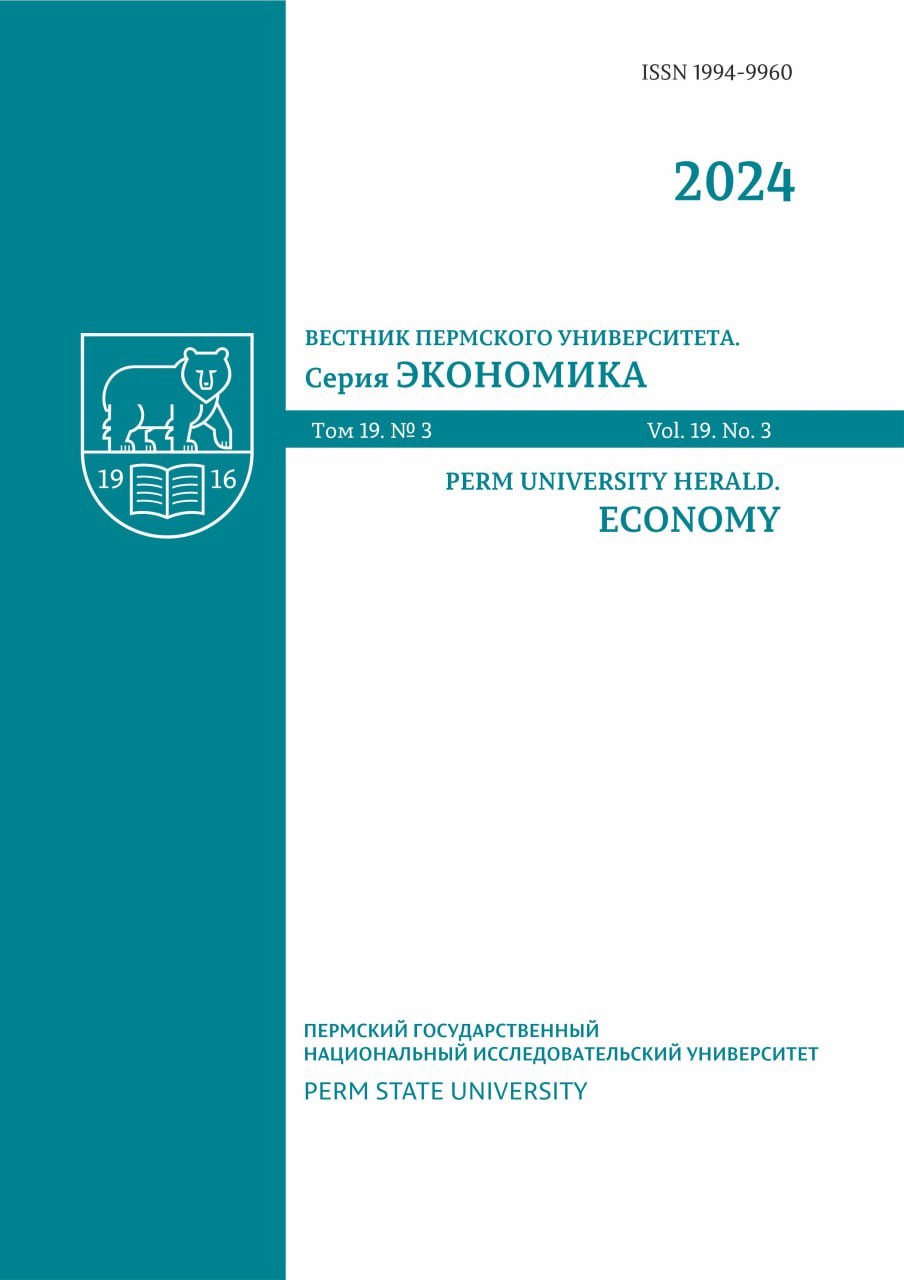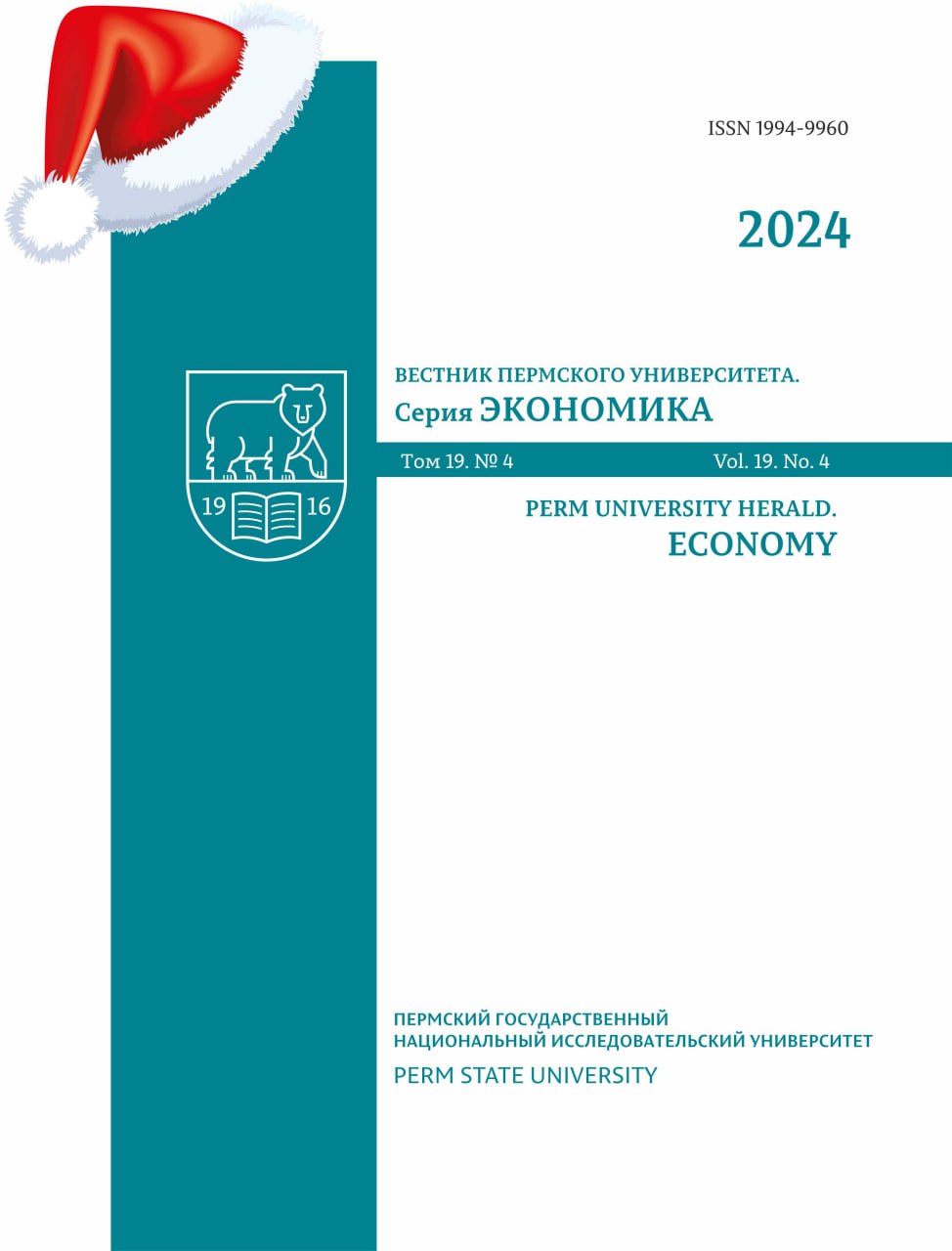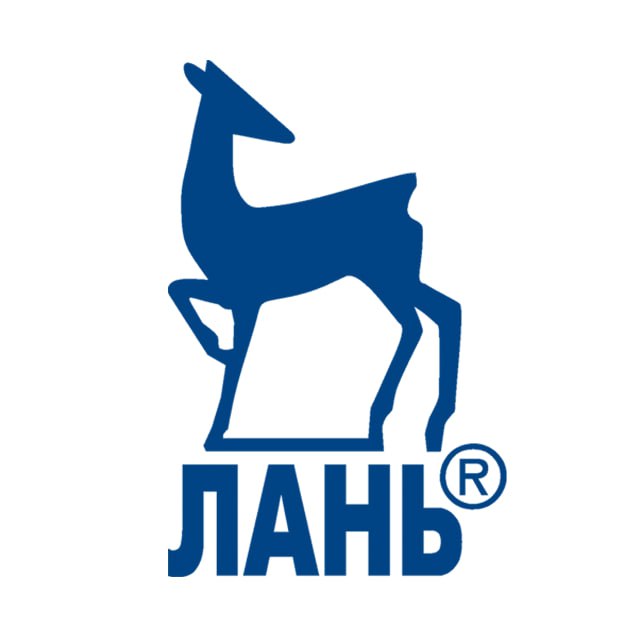Electrical capacity of products and its impact on regional economy
DOI:
https://doi.org/10.17072/1994-9960-2024-4-361-376Abstract
Introduction. The legislative acts adopted by the country’s leadership determine the relevance of the research topic, while their execution brings forward certain difficulties. It is considered to be a challenge for the state to simultaneously promote the economic growth of the Russian regions, comply with the requirements for sustainable development of territories, and reduce the use of energy resources for production.
Purpose. The purpose of the research is to determine the electrical capacity of products and its impact on the sustainable development of regional economies in order to adopt appropriate typological decisions by authorities. To do this, the growth rates of industrial production and electricity consumption were calculated.
Materials and Methods. The study refers to 2017–2022 Rosstat data on industrial production, energy consumption, and gross regional product. The basic method is applied to calculate the growth rates, and the grouping method is used to analyze the findings.
Results. The article considers a possible solution to a two-pronged problem when the authorities manage the growth rates of both industrial production and its electrical capacity. The findings reveal similar characteristics among the regions, which could categorize them intro groups. These groups show region-oriented electricity consumption, electrical intensity, and the developed structure of branches in regional economies, and could determine the impact of ongoing processes (indicators in questions) on the gross regional product. The proposed approach has both theoretical and practical significance: it facilitates the adoption of reference management decisions by regional authorities to manage the growth rates of independent variables.
Conclusion. The study is relevant as it words the research problem, proposes the assessment methodology for the growth rate of electrical capacity of industrial products, determines its impact on the sectoral structure of gross value added (sections B, C, D, E), which constitutes the gross regional product.
Keywords: industrial production, sustainable development of the territory, electricity consumption, gross regional product, energy efficiency, economic growth, growth rates, regional differentiation, grouping of regions
For citation
Belov V. I. Electrical capacity of products and its impact on regional economy. Perm University Herald. Economy, 2024, vol. 19, no. 4, pp. 361–376. DOI 10.17072/1994-9960-2024-4-361-376. EDN BDLVZA.
REFERENCES
- Mazurkin P. M. Electricity consumption in former Soviet Union without diversification of production and normalization. International Journal of Experimental Education, 2011, no. 10, pp. 24–31. (In Russ.). EDN RALEWZ
- Velikhov Е. P. Energetics in 21st century global economy. Proceedings of Moscow Institute of Physics and Technology (State University), 2011, vol. 3, no. 4 (12), pp. 6–15. (In Russ.). EDN OJYMTL
- Simonov N. S. Nachalo elektroenergetiki Rossiiskoi imperii i SSSR kak problema tekhnotsenoza. Moscow, Infra-Inzheneriya, 2017. 640 p. (In Russ.). EDN ZVBQAB
- Bertoldi P. Are current policies promoting a change in behaviour, conservation and sufficiency? An analysis of existing policies and recommendations for new and effective policies. ECEEE Summer Study proceedings. Stockholm, ECEEE, 2017, pp. 201–211. Available at: https://publications.jrc.ec.europa.eu/repository/handle/JRC106629 (access date 10.05.2024).
- Rosenow J., Fawcett T., Eyre N., Oikonomou V. Energy efficiency and the policy mix. Building Research & Information, 2016, vol. 44, iss. 5–6, pp. 562–574. DOI 10.1080/09613218.2016.1138803
- Shove E. What is wrong with energy efficiency? Building Research & Information, 2018, vol. 46, iss. 7, pp. 779–789. DOI 10.1080/09613218.2017.1361746
- Bushuev V. V. Energeticheskii potentsial i ustoichivoe razvitie. Moscow, Energiya, 2006. 320 p. (In Russ.).
- Nigmatulin B. I. Electricity intensity of GDP. Electricity tariffs for end consumers. Electricity prices at nuclear power plants in Russia and USA. Comparison with the world, OECD, USA, China and other countries. Proceedings of the Russian Academy of Sciences. Power Engineering, 2019, no. 6, pp. 19–42. (In Russ.). DOI 10.1134/S0002331019060074. EDN UEPJZE
- Sokolov М. М. How to reduce the energy intensity of the economy in Russia? Geoeconomics of energetics, 2022, vol. 20, no. 4, pp. 124–151. (In Russ.). DOI 10.48137/26870703_2022_20_4_124. EDN WVTJAJ
- Temnaya О. V., Agafonov D. V. Normalized GRP power intensity model with correlation-factor of regional electricity at-market value and other criteria. Lomonosov Economics Journal, 2024, vol. 59, no. 2, pp. 130–152. (In Russ.). DOI 10.55959/MSU0130-0105-6-59-2-7. EDN JMWGOK
- Zorina Т. G., Yurkevich О. I. Analysis of electricity intensity of GDP of the Republic of Belarus in the field of electricity consumption. Information and Mathematical Technologies in Science and Management, 2023, no. 1 (29), pp. 86–98. (In Russ.). DOI 10.25729/ESI.2023.29.1.008. EDN LPOAPM
- Kapansky А. А. Methods for solving the problems of evaluation and forecasting energy efficiency. Vestnik Kazanskogo gosudarstvennogo energeticheskogo universiteta, 2019, vol. 11, no. 2 (42), pp. 103–115. (In Russ.). EDN IZRBKX
- Plakitkin Yu. A., Plakitkina L. S. Energiya i prognozy mirovogo razvitiya: tendentsii i zakonomernosti. Moscow, MEI Publ., 2020. 220 p. (In Russ.). EDN UASXSD
- Prognoz razvitiya energetiki mira i Rossii 2019. Edited by А. А. Makarov, Т. А. Mitrova, V. А. Kulagin. Moscow, The Energy Research Institute of the Russian Academy of Sciences2019. 210 p. (In Russ.). EDN UUDYQJ
- Costa-Campi M. T., García-Quevedo J., Trujillo-Baute E. Electricity regulation and economic growth. Energy Policy, 2018, vol. 113, pp. 232–238. DOI 10.1016/j.enpol.2017.11.004
- Shvetsov А. V., Shvetsova N. К. Energy intensity and energy efficiency of the domestic economy in the context of socio-economic development of the regions. Vestnik of the Mari State University. Chapter “Agriculture, Economics”, 2023, vol. 9, no. 4 (36), pp. 451–461. (In Russ.). DOI 10.30914/2411-9687-2023-9-4-451-461. EDN TKVNBO
- Liddle B., Hasanov F. Industry electricity price and output elasticities for high-income and middle-income countries. Empirical Economics, 2022, vol. 62, pp. 1293–1319. DOI 10.1007/s00181-021-02092-6
- Filippov S. P., Malakhov V. А., Veselov F. V. Long-term energy demand forecasting based on a systems analysis. Teploenergetika, 2021, no. 12, pp. 5–19. (In Russ.). DOI 10.1134/S0040363621120043. EDN ZSCFTO
- Suganthi L., Samuel A. A. Energy models for demand forecasting. Renewable and Sustainable Energy Reviews, 2012, vol. 16, iss. 2, pp. 1223–1240. DOI 10.1016/j.rser.2011.08.014
- Dzyuba А. P. Comparative assessment of the electricity and natural gas consumption scale in the regions of the Russian Federation. Problems of Economics and Management of Oil and Gas Complex, 2023, no. 8 (224), pp. 13–27. (In Russ.). DOI 10.33285/1999-6942-2023-8(224)-13-27. EDN VYKDPT
- Mazurova О. V., Galperova Е. V., Loktionov V. I. Forecasting electricity demand in the Russian Federation and its regions taking into account electrification expansion. Ekonomika regiona = Economy of Regions, 2022, vol. 18, no. 2, pp. 528–541. (In Russ.). DOI 10.17059/ekon.reg.2022-2-16. EDN ARNODY
- Energoeffektivnost': reiting rossiiskikh regionov po elektropotrebleniyu za 1990–2010 gody. Elektrika = Electrics, 2010, no. 8, pp. 3–15. (In Russ.). EDN ZLSWFF
- Nekrasov S. А. Electricity consumption growth in Russian regions as a factor of their socio-economic development. Ekonomika regiona = Economy of Regions, 2022, vol. 18, no. 2, pp. 509–527. (In Russ.). DOI 10.17059/ekon.reg.2022-2-15. EDN NFXKWX
- Maza A., Villaverde J. The world per capita electricity consumption distribution: Signs of convergence? Energy Policy, 2008, vol. 36, iss. 11, pp. 4255–4261. DOI 10.1016/j.enpol.2008.07.036
- Wilk R. Consumption, human needs, and global environmental change. Global Environmental Change, 2002, vol. 12, iss. 1, pp. 5–13. DOI 10.1016/S0959-3780(01)00028-0











